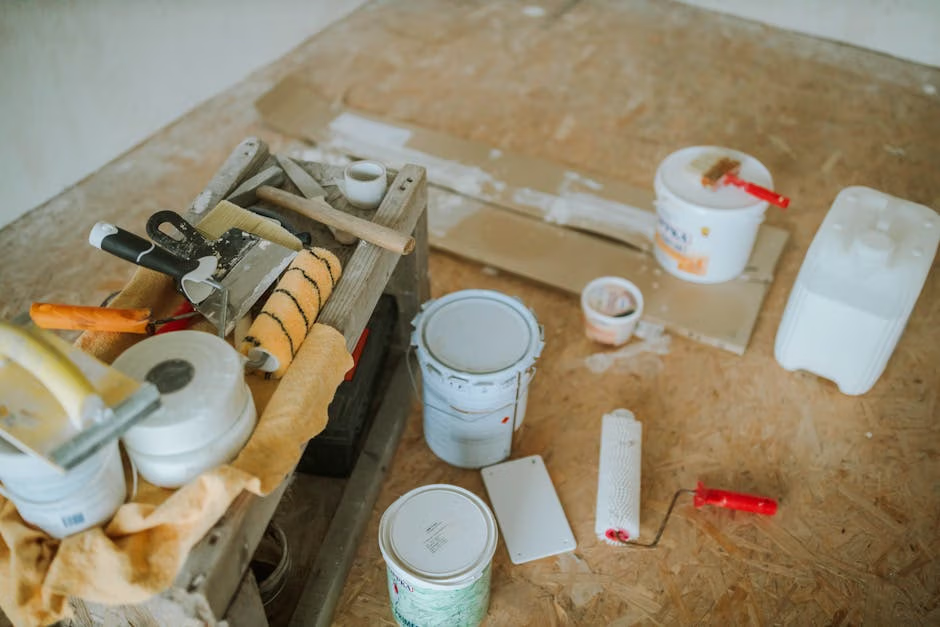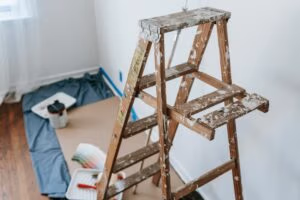Materials Needed for Painting Walls: Top Guide 2025
When it comes to changing a room, the materials needed for painting walls play a crucial role in achieving a professional finish. For a quick overview, here are the essentials that you’ll need:
- Painter’s Tape – Essential for crisp, clean lines.
- Drop Cloths – Protect surfaces from drips and spills.
- Painter’s Tray and Plastic Tray Liners – Load your paint roller evenly and simplify cleanup.
- Paint Brush and Roller – For detailed work and large surfaces, respectively.
Whether you’re a seasoned DIY enthusiast or just starting out, selecting the right materials can make or break your painting project. High-quality tools not only ease the process but also ensure a flawless outcome. From painter’s tape for those perfect edges to durable drop cloths protecting your surfaces, having the right arsenal is key.
The helpful team at Lowcountry Ace is here to guide you through the exciting journey of turning your blank canvas into a masterpiece. With extensive knowledge in home improvement projects, they can provide insight and support, ensuring that every stroke of your brush brings your vision to life.
Essential Materials Needed for Painting Walls
When preparing to paint a room, having the right materials is essential for a smooth and successful project. Here’s a breakdown of the materials needed for painting walls to ensure you get the best results:
Painter’s Tape
Painter’s Tape is a must-have for achieving those sharp, clean lines around edges and trim. Unlike regular tape, it’s designed to be easily removed without damaging surfaces or leaving residue. Remember to clean the surfaces before applying the tape for the best adhesion.
Drop Cloths
Painting can get messy, so protect your floors and furniture with Drop Cloths. Opt for leak-proof varieties to ensure that no paint seeps through. Whether you’re working in a furnished room or an empty space, these cloths are indispensable.
Paint Tray and Plastic Tray Liners
A Paint Tray is essential for loading your roller with paint evenly. Pair it with Plastic Tray Liners to make color changes and cleanup a breeze. Simply swap out liners instead of washing the tray every time, saving both time and effort.
Paint Brush
For detailed work and cutting in around corners, a high-quality Paint Brush is crucial. A 2-inch angled brush works well for most tasks, providing precision and control. Investing in a good brush prevents bristle loss and ensures a smooth finish.
Roller Frame and Roller Covers
Cover larger wall areas efficiently with a Roller Frame and Roller Covers. Choose a roller cover that suits your paint type and surface texture. For smoother walls, a short-nap roller is ideal, while textured surfaces may require a longer nap.
Extension Pole
An Extension Pole is a handy tool for reaching high walls and ceilings without a ladder. It attaches to your roller frame, making it easier to cover large areas quickly and safely. Look for adjustable poles for added flexibility.
Selecting the right tools can make your painting project more efficient and less daunting. The helpful team at Lowcountry Ace is always ready to assist you in choosing the best materials for your needs, turning your blank walls into a stunning masterpiece.
Preparing Your Walls for Painting
Before you dive into painting, it’s crucial to prepare your walls properly. This step ensures that your paint adheres well and looks flawless. Here’s what you’ll need:
Wall Cleaning Agents
Start with clean walls. Dust, grease, and grime can prevent paint from sticking, leading to uneven patches. Use a mild wall cleaning agent to wipe down the surfaces. For stubborn spots, a mix of water and mild detergent works wonders.
Tip: A simple dusting cloth can help remove loose particles before cleaning.
Sanding Paper
Once your walls are clean, it’s time to smooth them out. Use sanding paper to tackle any rough patches or old paint drips. A medium-grit sanding sponge can handle most jobs without creating a lot of dust. If you’re sensitive to dust, consider a damp sponge for smoothing out spackle.
Primer
A good primer sets the stage for your paint. It helps the paint adhere better, covers imperfections, and can even improve the paint color. Choose a primer that suits your wall type—whether it’s drywall, wood, or something else.
Remember: Priming is especially important if you’re painting over a dark color or a glossy finish.
White Filling Cement
For any cracks or holes, use white filling cement. This material fills in gaps and creates a smooth surface for painting. Apply it with a putty knife, and once it’s dry, sand it down to make it flush with the wall.
Pro Tip: Use fiber mesh tape for larger holes before applying the filling cement for extra support.
Preparing your walls might seem tedious, but it’s a game-changer for a professional-looking paint job. The helpful team at Lowcountry Ace can guide you in selecting the best products for your wall preparation needs.
Step-by-Step Guide to Painting Walls
Once your walls are well-prepared, it’s time to transform them from a blank canvas to a masterpiece. Follow this step-by-step guide to ensure a smooth and professional finish.
Cleaning Surfaces
Before you apply any paint, ensure your walls are spotless. Even after initial cleaning during preparation, dust can settle. Use a dusting cloth to gently wipe the walls again. This simple step removes any lingering particles that could ruin your paint job.
Applying Primer
Applying a primer is a must-do before painting. It acts as a base coat that helps the paint stick better and last longer. It also covers up any marks or previous colors, giving you a clean slate.
- Tip: If you’re painting over a dark color, consider a tinted primer to reduce the number of paint coats needed.
Cutting In
Now, let’s talk about cutting in. This is where you paint the edges and corners of your walls—areas that rollers can’t reach easily. Use a high-quality angle-sash paintbrush for this task.
- Pro Tip: Keep a steady hand and paint in long, smooth strokes to avoid visible lines.
Rolling Paint
Finally, it’s time for the main event: rolling the paint onto your walls. Use a roller frame with a microfiber roller cover for the best results. An extension pole can make this job easier, especially for high walls or ceilings.
- Load your roller evenly in the paint tray. A plastic tray liner can make this process cleaner and faster.
- Roll from top to bottom in a “W” pattern to cover large areas efficiently.
- Overlap your strokes slightly to ensure even coverage and avoid streaks.
By following these steps, you’re on your way to achieving a flawless finish. The key is patience and precision. The helpful team at Lowcountry Ace is always available to provide expert advice and recommend the best tools for your painting project.
Next, let’s tackle some frequently asked questions about painting walls to make sure you’re fully prepared for any challenges that might arise.
Frequently Asked Questions about Painting Walls
Which material is required for wall painting?
Before you start painting, it’s important to have a few key materials ready. Dusting cloths are essential for ensuring your walls are free of any dust or dirt that could interfere with the paint’s adhesion. You’ll also need scrapers to remove old, flaky paint and an evener to smooth out any imperfections on the wall surface. This preparation helps create a perfect canvas for your new paint.
What supplies do you need for painting walls?
When it comes to the actual painting, having the right supplies can make all the difference. Start with a paint tray and plastic tray liner. These will help you load your paint roller evenly and make cleanup easier.
An angle-sash paintbrush is perfect for cutting in edges and corners where a roller can’t reach. And for the main surfaces, a microfiber roller cover will give you a smooth, even finish. Microfiber rollers are great because they hold more paint and reduce splatter, making your job easier and cleaner.
What do you need before painting a wall?
Preparation is key to a successful paint job. Painter’s tape is a must-have to ensure crisp, clean lines around trim and other areas you want to protect from paint. Apply it carefully and remove it before the paint fully dries to avoid peeling.
Drop cloths are essential for protecting your floors and furniture from drips and splatters. Choose durable, leak-proof options for the best protection.
Finally, keep sandpaper on hand. It’s useful for smoothing out any rough patches on your walls before you start painting. Sanding helps the primer and paint adhere better, leading to a longer-lasting finish.
These materials and supplies are crucial for achieving a professional-looking paint job. The helpful team at Lowcountry Ace is always ready to assist you in selecting the best materials needed for painting walls and ensuring you have everything you need for your project.
Next, let’s explore some common painting techniques to lift your DIY skills.
Conclusion
At Lowcountry Ace, we pride ourselves on offering more than just a wide range of materials needed for painting walls. We provide a complete solution for all your home improvement projects, with a focus on exceptional customer service and local convenience.
Our store, located at the Riverland Market on Folly Road, serves the James Island, Folly Beach, and Charleston areas. We offer everything you need, from paint and tools to garden supplies and fishing gear. Whether you’re a DIY enthusiast or a professional, our knowledgeable staff is here to help you every step of the way.
One of the standout features of Lowcountry Ace is our home delivery service. We understand that transporting large or heavy items can be a hassle, so we offer convenient delivery options to bring your purchases right to your doorstep. This service ensures you can start your project without delay and enjoy a seamless shopping experience.
With our commitment to quality and customer satisfaction, Lowcountry Ace is your trusted partner in changing any blank canvas into a masterpiece. Whether you’re painting a single room or your entire home, we have the tools and expertise to make your vision a reality.
Visit our James Island location today and let us help you turn your painting project into a success.
Lowcountry Ace Hardware: Your one-stop shop for home improvement. We offer quality products from trusted brands and expert advice from our experienced staff. Located on James Island, visit us for tools, hardware, fishing gear, power tools, building materials, grills & smokers, electrical and plumbing supplies, and more.






